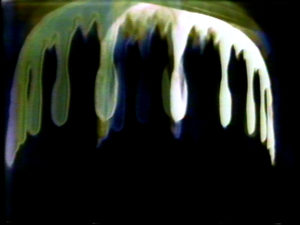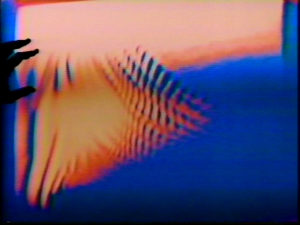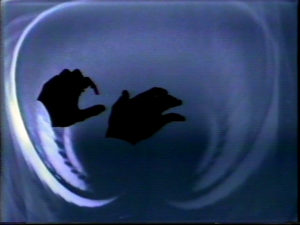Michael Betancourt on
Ron Hays
Ron Hays (May 5, 1945 – April 16, 1991) was part of the second generation of video artists, emerging at the start of the 1970s, whose work was characterized not by the invention of new imaging tools but by the aesthetic process—finding things to do with them. His work emphasized applications for video in a range of contexts that included broadcast, gallery/museum installation, and public performance, rather than a primarily formal exploration of the medium he called “electromedia” instead of “video” or “video art.” His career ended abruptly in 1991, when he died of AIDS at age 45.[1] Over the twenty years of his professional career, his innovative work with video, installation, and performance moved between the art world and commercial productions for both television and concerts.[2] His engagement with video as a medium for visual music placed his work within a longer tradition of artists such as light artist Thomas Wilfred or animator Oskar Fischinger who worked with synaesthetic imagery and kinetic abstraction. Hays’s own development of “music-image” stems from this historical foundation, which he gained through a specific study of their works during his time as the director of the “Music-Image Workshop” at WGBH in Boston. He worked with WGBH producer David Atwell to create a total of twenty-three performances, each thirty minutes long, broadcast locally in Boston.[3] His variant of visual music was specifically organized around the real-time manipulation and performance of visuals as an accompaniment/counterpoint to live musical performance. This emphasis on the immediacy of both music and visuals being created together at the same time is apparent in the twenty-minute tape Space for Head and Hands: an improvisation for prepared piano, voice, video switcher and synthesizer imagery. It was made in collaboration with conductor Michael Tilson Thomas (who performed on a prepared piano) and WGBH producer/director David Atwood (who ran the video switcher). Hays collaborated with Thomas for other performances as well, including the earlier WGBH Boston Symphony Orchestra Simulcast (in his role as guest conductor[4]) on April 2, 1973, for Ravel’s Daphnis and Chloé, and the later “Prelude to the Olympics” concert, Amphitheater of Light, performed live at the Hollywood Bowl in 1984.
Space for Head and Hands, 1976, video stills © Ron Hays
Space for Head and Hands: an improvisation for prepared piano, voice, video switcher and synthesizer imagery is broadly structured into three primary “movements”: the first two are clearly separated from the others, while the third, more complex section is a series of seven distinct parts linked to appear continuous by short transitions that recapitulate earlier visuals, making their independent identification ambiguous within the flow. Each section presents specific improvisations where either the visuals or the music “lead.” Each of the first two “movements” has a dominant visual motif that dynamically interacts with and responds to the musical structure, while the third moves between these earlier visual “statements,” implying a call-and-answer relationship between the musical performance and the visuals.
Even though the video is headed by the credit “MUSIC—IMAGE,” this tape is not a preliminary development but an application of the results obtained during his direction of the “Music-Image Workshop” at the public television station WGBH in Boston between June 1972 and January 1974, before these experiments moved to the separate facility created for the New Television Workshop in Watertown, Massachusetts. Hays’s grant report in 1974 explained his expansive goals for “music-image”:
Our objective is nothing less than to bring to music-image making the beginnings of a common grammar and framework. Without it, music-images will never attain the marks of a mature artistic discipline—to be both demanding and satisfying at a high order of creative expression.[5]
The synaesthetic aspects of this project guided his career as a whole. Hays’s imagery is a composite of multiple signals, a reflection of the capabilities of the Paik-Abe video synthesizer. The NEA/Rockefeller Foundation grant report on these “VideoLight” performances described the four image types that are employed throughout this tape: (1) wave-form, (2) sweep modulation, (3) sine and square oscillation, and (4) feedback.[6] These basic classes combine as the elements of a coherent, formal “grammar.” The organization of synthetic imagery and electronic live action compositing in Space for Head and Hands anticipates his later work with other video synth/compositing technologies with similar capabilities to the Paik-Abe synthesizer, such as Lee Harrison’s “Scanimate,” used at the end of the 1970s for the Pioneer Laserdisc Music-Image: Odyssey (released through Twentieth Century Fox/ Magnetic Video in 1979).[7] The dynamic set-up between musical performance and visual generation in Space for Head and Hands is evident from the shifts between shots where the recognizable imagery of Thomas contains and restricts the free-flowing abstractions, and the shots dominated by the abstractions. The shifts between abstraction contained by the head/hands and its presentation as an interactive background becomes increasingly complex as the third section continues. This oscillation of inside versus outside suggests a synaesthetic exteriorization of internal imagery through music. The idea of music as a transformative, synaesthetic “force” explicitly animates Space for Head and Hands—it depicts an imaginary space where the symmetrical feedback spirals that dominate the video are also the centers of eye sockets that have been put into motion. This iconography directly confronts the psychedelic and synaesthetic concerns of abstraction by transforming them into the meaning of the progression rather than an implicit assumption.
In the first section of Space for Head and Hands, these visuals are organized around imagery of hands; this is followed by a second section where the hands interact with a field of color; in the third section, the head is the main focus of the compositions. Both Hays and Thomas improvise and respond to each other’s actions—visual and musical—creating a real-time interplay of their audio-visual performances apparent in the discrete sections of the tape.[8] These shots appear as both masked overlays that contain the flow of abstract video, or as dark shapes apparently interacting and overlaid onto those same visuals. A consistent interplay between mask-form (hands, head) and video-processed field dynamically shows the shifts between internal and field imagery: the progression moves fluidly between imagery contained within the mask-forms and the appearance of black shapes (hands) interacting or moving across a field of abstract kinetic imagery.
In displacing the imagery between inside and outside of these masked forms, Hays’s “music-image” reveals its synaesthetic roots: the performance recorded on this tape demonstrates the transfer of interior, subjective music-imagery into the objective form of the video tape. The movement between imagery (“music”) being inside the performer and appearing outside as a material force and substance illustrates the historical conceptions of both synaesthetic imagery and visual music as revelations of an unseen, universal real that exists apart from the mere appearances of everyday reality. This understanding aligns his approach with other visual music performers and the “video music” approach to video art common in the 1970s, apparent in the contemporary work of other artists who were also closely engaged in synaesthetics, such as the Electronic Visualization Laboratory[9] run by video artists Dan Sandin and Tom DeFanti in Chicago, or in the video dance works of artists such as Doris Chase, active in New York.[10] Unlike many of his contemporaries, Hays was publicly prominent. At the public television station WGBH-TV in Boston, Space for Head and Hands was central to the ongoing experiments in the 1970s into the social and aesthetic potentials of video/television as an artistic medium.[11] Hays’s conception of “music-image” identified these possibilities with the flow or progression of synaesthetic visuals synchronized with music:
The synthesizer is essentially an optical color generator, capable of taking the inputs of multiple black-and-white cameras and transforming them into an infinite number of colors, designs and patterns. It should be emphasized that the synthesizer has no direct hook-up to music or sound waves—it is manually operated, producing images of the artist’s choice. […] After seven months, I discovered a methodology that allowed me to choose freely those movements of light and forms that worked well together with the music and each other. I absorbed a sense of the instrument’s controls: I reached a point where I could combine the individual variables—the brightness of outlines, the intensity of color, the frequency and amplitude of wave forms, and (most importantly) the visual feedback from the many cameras focused on their own monitor screens—where after much rehearsal I could combine all these things in a single effort/performance to produce (and reproduce) the music-image flow I wanted.[12]
“Real time” audio-visual performances of the type in Space for Head and Hands, where visual synchronization with music creates the finished work, defines Hays’s music-image concept. The Paik-Abe synthesizer at WGBH provided him with access to technical equipment not generally accessible to the public,[13] which was required to develop and implement this approach to media production. His later development in the 1980s in southern California expanded this performative engagement with sound and image synchronization to include both lasers and multiple projection as a visual counterpoint for concerts. In Space for Head and Hands, this later development is nascent: the dynamic interplay between live video feeds, the synthesizer’s processing, and the immediacy of the apparent interactions—most obvious when the hand’s actions seem to inflect the progression of the visuals—demonstrate an aesthetic of synaesthetic immediacy where the flow of abstract forms and the sequence of music converge as the performance. Hays’s expansion of this dynamic beyond the confines of the television screen into an environmental (expanded cinema) presentation is a logical extension of “electromedia,” since his music-image was never confined to the particulars of video technology.
The problems of audio-visual synchronization (and their linkage in visual music) are recurring issues in media art that unify the work of video artists in the 1970s with the invention of commercial music videos in 1980s. The disembodied head iconography, so central to Space for Head and Hands, will reappear in Hays’s 1981 music video for the hit “Let’s Groove” by the band Earth, Wind and Fire—a video that transforms the difficult, avant-garde aspects of his early work into a familiar and highly accessible commercial presentation simply by changing the musical score from Michael Tilson Thomas’s improvisation with a prepared piano to EWF’s electronic pop music, a change prepared by his 1979 laserdisc Music-Image Odyssey, which also used disco in its soundtrack. (“Delta 1” is from the album Games by Synergy.[14]) Both later videos affirm the central role that Space for Head and Hands has in his development: it reveals these seemingly major shifts as matters of degree, a difference of musical style, rather than a fundamental distinction or radical change. This anticipatory quality, apparent in retrospect, reveals how the trajectory of Hays’s career as a whole is incipient in his early work at WGBH.
[1] Burt A. Folkart, “Ron Hays; Multimedia Conceptualist,” LA Times, April 19, 1991.
[2] “Biography for Ron Hays,” LA ACM Siggraph, https://la.siggraph.org/presenter/ron-hays (accessed May 12, 2005).
[3] Johanna Branson Gill, “Video: State of the Art,” Pioneers of Electronic Art, Vienna: Ars Electronica, 1992, pp. 70–71.
[4] “Future Programs: Spectrum Series,” Boston Symphony Orchestra Ninety-Second Season 1972–73, p. 149.
[5] Ron Hays, Report of Activities: June 1972 through January 1974, grant report to the Rockefeller Foundation and National Endowment for the Arts, 1974, p. 1.
[6] Ibid.
[7] Jeffrey Schier, “Lee Harrison,” Pioneers of Electronic Art (Vienna: Ars Electronica, 1992), pp. 92–96.
[8] “A Dual Improvisation,” News from Electronic Arts Intermix, n.d.
[9] Gene Youngblood, “Art and Ontology: Electronic Visualization in Chicago,” The Event Horizon, eds. Lorne Falk and Barbara Fischer, Toronto: Coach House Press and The Walter Phillips Gallery, 1987.
[10] Sherry Miller Hocking and Rich Brewster, “Image Processing,” Pioneers of Electronic Art, Vienna: Ars Electronica, 1992, p. 180.
[11] Felicity D. Scott, “Networks and Apparatuses circa 1971: Or, Hippies Meet Computers,” Hippie Modernism: The Struggle for Utopia, Minneapolis: Walker Art Center, 2015, pp. 108–110.
[12] Ron Hays, “Synthesizer and Symphony,” Prime Time Magazine, April, 1973, p. 11.
[13] Michael Shamberg and Raindance Corporation, “Manual,” Guerrilla Television, New York: Holt, 1971.
[14] John Coulthart, “Ron Hays Music Image: Odyssey,” posted September 28, 2015 https://www.johncoulthart.com/feuilleton/2015/09/28/ron-hays-music-image-odyssey/ (accessed June 2, 2017).


